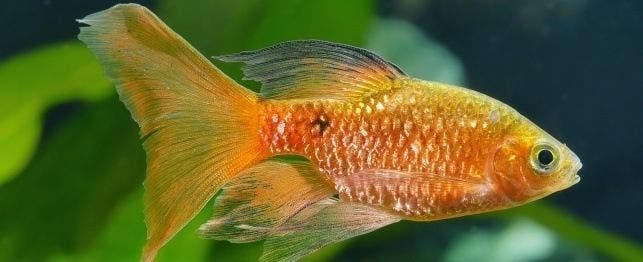
Anesthesia in Fish
Anesthesia is the loss of sensation and loss of the ability to feel pain. Fish are anesthetized for a variety of procedures such as examination, transportation, diagnostic sampling and surgery. Since many of these procedures are more easily performed out of the water, a condition objectionable to most fish, effective restraint is essential. Chemical immobilization is usually less stressful and traumatic than physical restraint for minor procedures, and for major procedures the use of an anesthetic agent is required. When necessary, overdose of anesthetic agents is an acceptable means of euthanasia.
Anesthesia for fish is usually delivered in the water, and is therefore essentially inhalation anesthesia (like gas anesthesia for mammals), as the anesthetic agent is absorbed across the gills. Injectable anesthetics commonly used in mammals are less effective in most fish species.
For short-duration of less than 5 minutes diagnostic procedures such as skin scrapings and gill biopsies, inexact addition of anesthetics “to effect” have traditionally been used. In this approach, the anesthetic is sprinkled or poured into the water until the fish loses balance and becomes non-responsive. The procedure is then performed as quickly as possible and the fish is returned to anesthetic-free water to recover.
While this approach can work for minor procedures, it is not advised for longer, more intricate surgery. Continuous delivery to the gills of known concentrations of anesthetic in water is required for longer procedures. A low-cost and portable recirculating system utilizes a standard power head pump, flexible plastic tubing and clamps, an open cell foam surgery platform cut to fit the patient, and an acrylic support fitted to an aquarium of suitable size. The fish is put under anesthesia by immersion in a separate tank with a known concentration of anesthetic, and then removed to the surgery platform. Water containing anesthetic is pumped from the tank and over the gills, and percolates through the foam platform and off the acrylic support back into the tank for recirculation. Fish can be maintained on anesthesia for procedures lasting over two hours with such systems.
Anesthetic Agents
A wide variety of anesthetic agents have been used in fish. Two of the more commonly used anesthetics today are tricaine methanesulfonate (MS-222) and eugenol. Isoflurane, an anesthetic used in vaporizers for gas anesthesia of mammals and birds, may also be mixed into water for fish anesthesia, although precise dosing and volatization are problems.
Tricaine is the most commonly used fish anesthetic. It comes as a fine white powder which can be weighed for the proper dose, or premixed in a convenient stock solution for addition to the anesthesia tank by volume. Tricaine solutions are acidic and they should be buffered prior to use with sodium bicarbonate (baking soda).
An alternative to tricaine is eugenol, the active ingredient of clove oil. Eugenol has been used widely in koi for minor procedures, but has a limited history of use for major surgery. Eugenol is not completely soluble in water and may be diluted in 95 percent ethanol for a stock solution. Eugenol produces similar effects as tricaine at lower doses.
Cold Is Not An Anesthetic
Chilling a fish in the refrigerator is one way to slow it down and reduce responsiveness. While the fish is then easier to handle, cold does not eliminate the sensation of pain. Furthermore, chilling the fish can impair its immune system and may make it more susceptible to infections following the procedure. Chilling is NOT recommended as an alternative to anesthesia for restraint.
Anesthetic and Pre-anesthetic Considerations
Prior to anesthesia, your veterinarian will request that you not feed your fish for one feeding cycle. A fish with a full stomach may regurgitate under anesthesia and clog its gills partially and foul the water. Separate supplies of water for anesthesia induction, anesthesia maintenance and anesthesia-free water for recovery should be available before starting any procedure.
Minimize stress on the fish, as an excited fish will not experience a smooth anesthesia event. Dim lights help reduce stimulation of the fish. The fish should be handled carefully (and minimally) to avoid abrasions and loss of protective mucus. The anesthesia water needs to be well aerated, because under anesthesia, breathing (gilling) will be reduced. Fish being induced with anesthesia may go through an excitement phase as inhibitory neurons are depressed and before anesthesia is achieved, so a cover on the induction tank is a good idea. Skin and fins must be kept moist throughout the out-of-water experience for the fish.
Anesthetic Delivery Systems
Anesthetics can be delivered by immersing the fish in a tank or bucket of water containing the anesthetic, or once out of water by a recirculating or non-recirculating system. In a non-recircultating system, anesthesia water passes only once over the gills and then goes to a waste collection. In a recirculating system the anesthesia water is collected in a sump and delivered repeatedly to the gills. In both systems anesthesia water can be delivered through tubing sized to fit the fish’s mouth, by gravity feed, manually, for example, pushed from a large syringe or turkey baster, or mechanically as described above with a power-head pump. Non-recirculating systems work best for small fish and short procedures.
Anesthesia Recovery
For recovery from anesthesia the fish is placed in anesthetic-free water. If it is not respiring (gilling) well on its own, water is directed over the gills by pulling the fish forward through the water or by using a syringe or pump. Respirations will gradually strengthen, normal upright attitude will return, and the fish will resist restraint. Even once the fish is recovered and appears outwardly normal, it may remain hypoxic (low blood oxygen levels) for some time, so maintaining adequate aeration of the water is important.